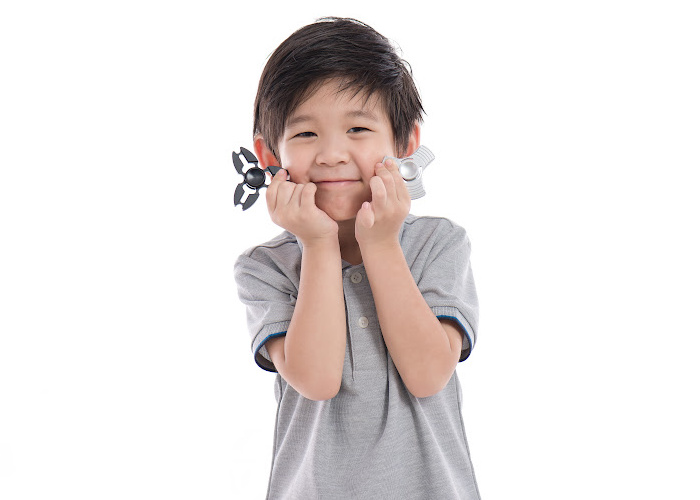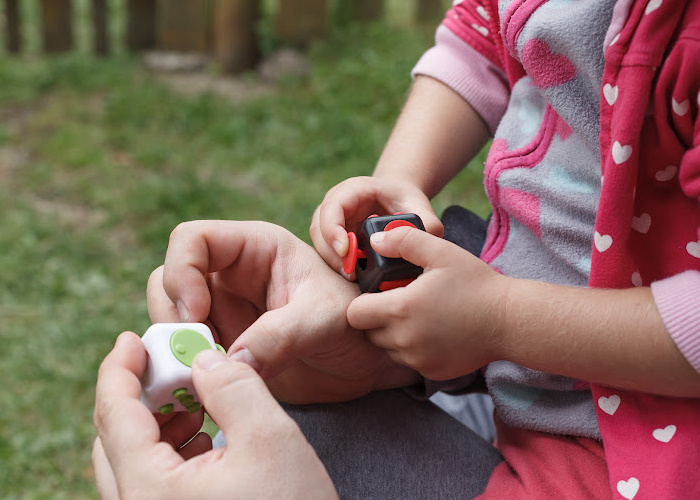It's crucial to know that students with autism and ADHD need special study strategies. Autism…

Understanding Why Autistic Children Stim and How to Support Them
For parents and educators observing why autistic children stim, understanding these behaviors goes beyond mere curiosity. Comprehending the nuances of sensory seeking behaviors in autism is key to supporting autistic individuals in regulating stimming.
Stimming, short for self-stimulating behavior, involves a range of actions, from the conspicuous, such as body rocking, to the less noticeable, like hand flapping. While originally thought to be limited to the autism spectrum, such behaviors are part of the human experience, also manifesting in neurotypical individuals in various forms.
The aim to support rather than stifle is paramount. By appreciating the role of stimming as a tool for sensory reinforcement and emotional equilibrium, we shift towards strategies that respect and adapt to the needs of the individual. This introduction leads into an empathetic exploration of stimming, laying the groundwork for insightful discussion on effective support mechanisms.

The Nature and Purpose Behind Stimming in Autistic Children
Stimming a term frequently mentioned in discussions about autism is a behavior not unfamiliar to many, yet deeply significant within the context of Autism Spectrum Disorder (ASD). To truly grasp the concept of understanding stimming in autistic children, we delve into its core, revealing the multifaceted roles it plays in providing comfort, coping mechanisms, and a means to manage sensory overload in autistic children.
In learning about causes of stimming in autism, we uncover a labyrinth of sensory and emotional layers, each influencing the prevalence and type of stimming behaviors observed. Looking beyond the surface, it becomes clear that these routines, from rocking to hand-flapping, are more than they seem they are a silent language speaking volumes about the intricate inner workings of those with ASD.
Defining Stimming and its Occurrence in ASD
Within the autism community, stimming represents a variety of repetitive movements or sounds, often instinctive reflections of the inner state. From the full-body engagement of spinning to the subtle tapping of a finger, these self-stimulatory behaviors serve as a bridge, often helping individuals with ASD navigate the complexities of their sensory experiences.
Sensory Processing: The Link to Stimming Behaviors
Experiencing the world in high-definition that’s one way to describe the sensory processing that occurs in many autistic individuals. These heightened sensory experiences can either overwhelm or underwhelm, driving the need for stimming as a form of self-regulation. Whether acting as a shield against sensory overload or as a tool to solicit additional stimuli, stimming emerges as an invaluable asset for emotional and sensory equilibrium.
Identifying Different Forms of Stimming
The types of stimming in autism are as diverse as the individuals themselves. Some common forms include:
- Body rocking
- Hand flapping
- Echolalia (repeating sounds or phrases)
- Finger flicking
- Pacing
- Visual stimulation, such as staring at rotating objects
Each of these behaviors might be a means to find relief, balance emotions, or assert control over a world that can often seem too intense or too lacking in stimulus. By recognizing these patterns, we advance our quest in understanding stimming in autistic children, which in turn, enhances our ability to provide compassionate support and guidance.

Why Do Autistic Children Stim: Exploring the Causes
Stimming in autism, a behavior characterized by its repetitive nature, serves many purposes and is a considerable focus when managing stimming in children with autism. A deeper understanding of the causes of stimming in autism can illuminate why these behaviors are vital to autistic children, often bringing numerous benefits of stimming for autistic children. Let’s explore the multifaceted reasons behind stimming, which span an array of sensory and emotional domains.
Autistic children may exhibit stimming behaviors as a reaction to their sensory environment. Both sensory overstimulation, where the senses are bombarded with more input than they can process, and sensory under-stimulation, where there is a craving for more sensory information, can incite these self-stimulatory actions. Stimming acts as a personal regulator, aiding autistic individuals in finding their balance and comfort within their own sensory landscape.
In addition to aiding in sensory processing, stimming can offer significant relief from physical pain and play a crucial role in emotion management. For some autistic children, engaging in specific stimming behaviors can lessen feelings of anxiety and foster happiness. It’s a tool that empowers them to express and process emotions that might otherwise be too overwhelming to handle internally.
Stimming also stands as a key component of self-regulation, often serving as a soothing presence in the lives of autistic individuals. From the pressures of social interactions to the mundane lulls of daily life, stimming can be a response to various triggers – including stress, anxiety, excitement, boredom, and physical discomfort. Understanding this aspect is essential when considering approaches for managing stimming in children with autism.
To differentiate between stimming as a symptom and stimming as a coping mechanism, medical assessments are crucial. Evaluations can help exclude physical issues such as migraines or ear infections that might be causing or exacerbating stimming behaviors. With a clearer picture, managing and supporting these behaviors become more focused on embracing the functional and benefits of stimming for autistic children rather than attempting to eliminate a core component of their experience.
Recognizing that each child’s stimuli triggers are distinct and that stimming fulfills various needs, caregivers and professionals can align their support with the child’s unique way of experiencing the world. This comprehensive understanding paves the way for compassion and tailored management strategies that respect autistic children’s adaptive efforts to their sensory and emotional environments.
Support Strategies for Managing Stimming Behaviors
When addressing managing stimming in children with autism, it is essential to consider an array of supportive strategies that cater to each child’s unique needs. Navigating the complexities of stimming behaviors requires a thoughtful and personalized approach that prioritizes the well-being and development of autistic individuals.
Creating a Safe and Understanding Environment
In crafting a supportive environment, it is crucial to minimize factors that stimulate sensory overload. Ensuring a comfortable and predictable setting can play a pivotal role in reducing stimming behaviors in autism. This includes adjusting lighting, minimizing noise, and creating personal safe spaces where children can relax and feel secure.
Alternatives to Stimming: Finding Other Forms of Sensory Input
Engaging autistic children in activities that provide appropriate sensory feedback can serve as effective alternatives to stimming. Introducing sensory-rich experiences like:
- Physical activities that involve different muscle groups
- Play with tactile materials such as play dough or slime
- Use of visual supports like color-coded schedules
These alternatives not only help in managing stimming in children with autism but also contribute to their overall sensory development.
Engaging in Positive Reinforcement and Supportive Practices
Positive reinforcement is a cornerstone in encouraging autistic children to engage in desired behaviors. By recognizing and rewarding efforts to use alternative sensory strategies or more socially acceptable forms of self-regulation, caregivers and professionals can reinforce progress, simultaneously supporting autistic individuals in regulating stimming. Such validation from a caring and relatable perspective fosters trust and motivates continued growth.
Additionally, incorporating structured activities and consistent routines that promote a sense of order and predictability can significantly assist in managing stimming behaviors, allowing children to thrive within their environment.
Conclusion
In summarizing our journey towards understanding why autistic children stim, it’s evident that stimming serves as a lifeline, affording individuals a way to manage sensory imbalances and emotional upheaval. Recognizing the diverse motives that underpin these sensory seeking behaviors in autism equips us to foster supportive environments that cater to the needs of those on the spectrum. The quest to completely suppress stimming is not only unrealistic but also unnecessary; instead, our focus should be on supporting autistic individuals in regulating stimming in a manner that values their well-being.
Through the thoughtful modulation of environments, we can significantly alleviate the challenges associated with stimming behaviors. Implementing changes to lighting, sound, and personal spaces allows for the reduction of sensory overload, which can trigger stimming actions. Supplementing these efforts with alternative sensory-rich activities affirms autistic children’s necessity for certain sensory inputs, thus helping manage stimming without casting it as a negative behavior.
Positive reinforcement remains a powerful tool in this programming, thus recognizing small victories and reinforcing desirable alternatives plays a pivotal role. Caregivers and educators contribute to a nurturing climate that understands and appreciates the unique worlds autistic individuals navigate daily. This supportive scaffold of strategies, centered on patience and care, is paramount in creating a world where autistic individuals are not just included but celebrated for their distinctive ways of experiencing life.
FAQs
Why do autistic children stim?
Autistic children stim to manage sensory input, regulate emotions, provide sensory reinforcement, or as a response to brain function. It helps them to cope with sensory processing issues, including both sensory overload and sensory deprivation.
What is stimming in the context of autism spectrum disorder (ASD)?
Stimming, or self-stimulatory behavior, in ASD refers to repetitive body movements or movements of objects. It is a common characteristic of ASD and includes behaviors like hand-flapping, rocking, spinning, or repetitive vocalizations.
How does sensory processing relate to stimming behaviors?
Sensory processing issues are commonly found in autistic individuals, who may experience hypersensitivity or hyposensitivity to sensory input. Stimming behaviors can arise as a way to modulate this sensory input to a more tolerable level, either by creating a sensory stimulus or by offsetting overwhelming sensations.
What forms can stimming take in autistic children?
Stimming can involve a wide range of behaviors, such as visual stimming (staring at lights or moving fingers in front of the eyes), auditory stimming (humming or tapping), tactile stimming (rubbing surfaces or skin), vestibular stimming (rocking or spinning), and proprioceptive stimming (jumping or deep pressure).
What are some causes of stimming in autism?
Causes of stimming can include the need for sensory feedback, emotional regulation, pain relief, and self-regulation. It may also be driven by stress, anxiety, excitement, or even boredom.
Are there benefits to stimming for autistic children?
Yes, stimming can provide several benefits, such as self-soothing during stress, enhancing focus, alleviating sensory overload, expressing emotions, and alleviating discomfort or pain.
How can parents and professionals support autistic individuals in regulating stimming?
Support can include creating a sensory-friendly environment, providing alternative forms of sensory input through sensory diets, engaging in activities that give sensory feedback, teaching self-regulation strategies, using positive reinforcement, and understanding the function of the stimming behavior for the individual.
What strategies can be used to manage stimming behaviors in children with autism?
Strategies for managing stimming behaviors can include behavioral interventions like Applied Behavior Analysis (ABA), offering sensory alternatives, creating structured routines that include physical activity, and environmental modifications to reduce sensory triggers.
Can stimming behaviors be reduced in children with autism?
While some stimming behaviors can be reduced through various interventions and strategies, it is important to recognize that stimming serves a purpose for the individual. Instead of aiming to stop stimming entirely, the goal should be to help the individual manage it in a way that is healthy and adaptive.
What is the significance of supporting autistic individuals in regulating stimming?
Supporting autistic individuals in regulating stimming is crucial for their well-being. It acknowledges their unique sensory experiences and emotional needs, helping them to participate more fully in daily life and reducing potential stress and anxiety arising from unmanaged stimming.



This Post Has 0 Comments